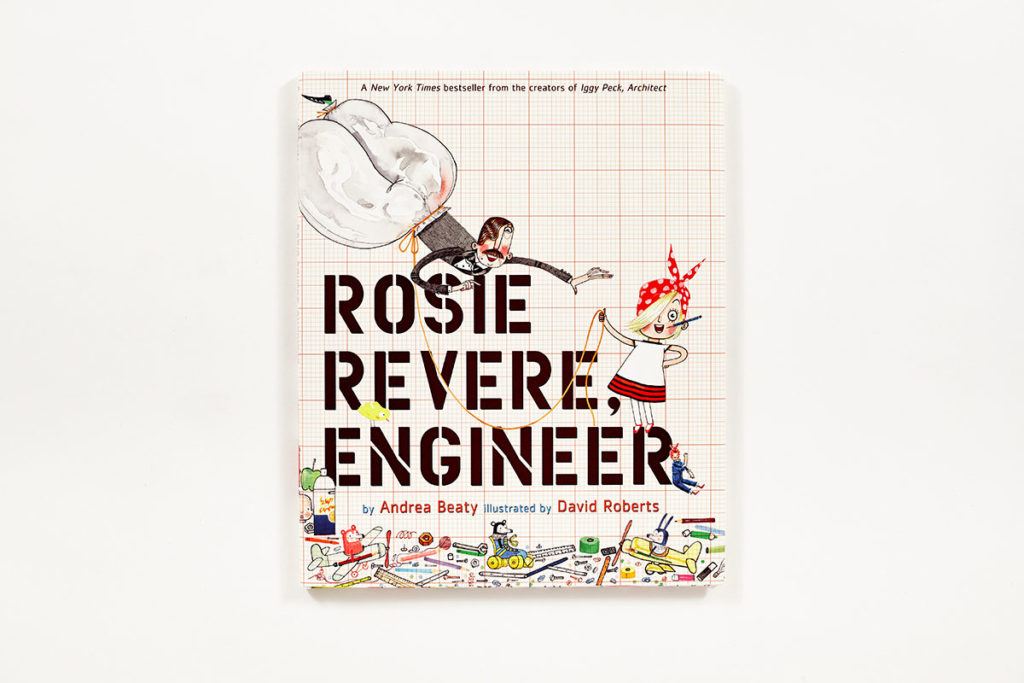About a year ago, I visited my master’s thesis supervisor. When knowing that I wanted to center my thesis on girls’ representation in children’s literature, she said, “do you know Andrea Beaty? She’s the author of the picture book Rosie Revere, Engineer. You should check that book out.”
So I did. In fact, after the first book, Rosie Revere, Engineer, I couldn’t help but finish all the other three books in the series. How couldn’t I love them? They all have bright, whimsical illustrations and humorous, rhyming texts that hold such a special charm. But among them all, I would still nominate Rosie Revere, Engineer for the most inspirational and delightful one for children (and even adults) to read. This picture book talks about more than a little girl’s engineer dream. It addresses a wider range of topics, such as child-adult power dynamics, girls in STEM, and children’s conflict management.
Rosie Revere dreamed of becoming a great engineer. She was so creative and passionate about engineering that she could make her inventions just from odds and ends. Hot dog dispensers, helium pants, python-repelling cheese hats… These were all designed and created by herself!
Although she had many surprisingly ingenious ideas, Rosie was shy and never spoke her engineer dream out loud. It was all because of an incident that happened when she invented a python-repelling cheese hat for her uncle Fred, a zookeeper. When Rosie showed Fred the python-repelling cheese hat, she was very serious and was proud of her new invention. But Fred “laughed till he wheezed, and his eyes filled with tears”. Even when Rosie showed that she was “embarrassed, perplexed, and dismayed”, he still pretended that he loved it (“‘I love it,’ Fred hooted, ‘Oh, truly I do.’”). This seems to be a typical scene where an adult unconsciously silences a child: Rosie cared about Fred and treated him as an equal, but she didn’t receive the same respect from Fred. He considered the hat as an unserious gadget made by an incapable child. Fred didn’t believe that a little girl was able to create a capable invention that could prevent him, an adult, from vital danger. In the end, this incident made Rosie decide to only keep her engineer dream to herself and not talk about it to anyone.
Then it was the fateful visit from Rose’s great-great-aunt Rose. Rose who wore a blue jumpsuit with a red polka-dot bandana, was clearly Rosie the Riveter, a cultural icon of World War II and a representation of the beginning of American feminism. The positive, gendered message here couldn’t be more obvious: women and girls are at work and they can be empowering engineers!
To help great-great-aunt Rose realize her dream of flying in the sky, Rosie designed and built a heli-o-cheese-copter. But her heli-o-cheese-copter crashed in the first flying test. When Rosie felt upset about her failure, Rose stepped out and taught Rosie (and all young readers) that the first flop isn’t something to fear. Instead, it’s something to celebrate. Together, Rosie and Rose started a new design to build a better aircraft.
Again, this isn’t only a girls’ self-esteem book. This is also a book that teaches the importance of failure in the journey of chasing one’s dream. I’m in awe of Beaty’s choosing failure as a topic that hasn’t been tapped into a lot yet. By addressing a general topic, failure, that most children would encounter in their life, this book avoided preaching about how hard or how rewarding a female engineer’s experience could be. In this way, it becomes very natural in this book that girls actively engage themselves in an engineering career. I love how this book normalizes topics such as science, technology, and engineering for girls. We need more books like this!
-Yuwen Zhang
Junior Girl
Girl Museum Inc.

